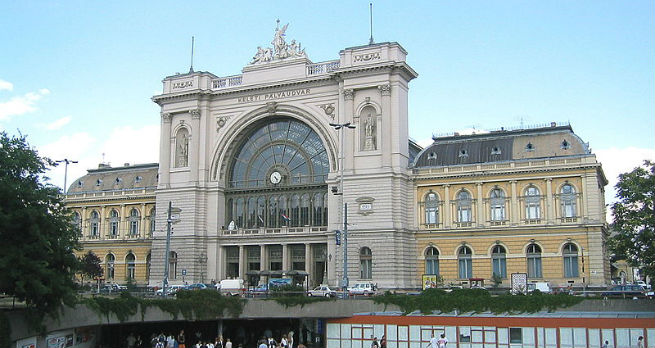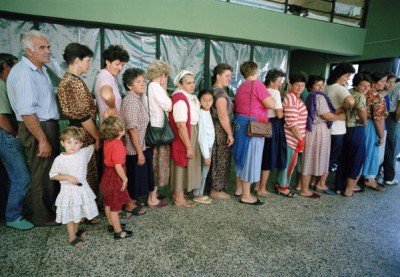After being blockaded for days, Budapest’s main rail terminal has been reopened to migrants and refugees desperate to settle in the EU.
An estimated 3,000 people had been camped outside the station, and once it was reopened at least 1,000 rushed in to try and board trains – although there were none to board since departures to Western Europe had been cancelled for “security reasons”. The Hungarian authorities reinstated the policy of registering all migrants before allowing them to leave the country, a demand issued by various European leaders including Angela Merkel.
 From railway line to immigration frontline: Keleti Station
From railway line to immigration frontline: Keleti Station
This remarkable series of events highlights the extreme intolerance that has characterised Hungarian politics for some time. But it must also serve as a warning to the rest of Europe. Hungarian xenophobia is becoming a template for rightist movements across the continent.
In 2014, I conducted research on anti-immigrant feelings in Hungary and Turkey, and it was clear to me that fear of migrants was far outpacing the reality of the “threat”.
While there were already signs that Turkey was becoming a major destination for refugees leaving Syria, there was little indication that Hungary would also feel the brunt of the refugee crisis caused by wars in the Middle East. Given its position in central Europe, you might think Hungary would have little to fear from prospective refugees. But the number of immigrants rarely bears any relationship to the fear of them.
Right after the EU accession, a 2007 opinion survey saw 80% of Hungarians say they would not welcome ethnic groups such as Arabs, Chinese and Russians into their country. The same refusal rate applied for the Pirez – a completely fictitious group added into the survey.
So it is perhaps not surprising that the actual arrival of migrants and refugees in Hungary this summer has caused such a stir.
Blazing a trail
In its response to the influx of migrants, Hungary’s conservative government – a coalition led by the Fidesz party – has blazed a trail for the continent’s far right.
Prime minister Viktor Orbán has pushed the view that left-liberal proponents of multiculturalism and migration in Europe are trying to destroy European societies and Europe itself.
This narrative is not only driving a wedge between the pro-EU and the EU-sceptical and EU-rejectionist camps in Hungary, but is also turning Orbán into an icon for sympathetic right-wing politicians across Europe inclined to pursue “illiberal” solutions to Europe’s problems.
Then there’s the problem of how to delineate the internal and external borders of the European Union in the face of a humanitarian catastrophe unfolding in the immediate vicinity.
Climate of fear
Hungary has long been polarised over Europe. Fidesz and its sister party KDNP (the Christian Democratic People’s Party) have stirred up popular fear and hatred of the West, of Western capitalism, and of Western lifestyles, which promote “unnatural” relationships.
Fidesz has styled itself as a guardian of “Europe” against the threat of the “West”, after the fashion of Russian Eurasianism – as well as railing against the influx of refugees and migrants to the EU. By framing the refugee crisis in the country as a threat to jobs, welfare, and society in Hungary and Europe alike, Orbán is trying to reinforce his image as a guardian against outsiders, both Western and otherwise.
Developments such as the rise of the extreme right’s Jobbik party have only upped the ante. With a controversial “national consultation” questionnaire sent to voters and a massive public campaign with placards telling migrants in Hungarian that they should not come to Hungary to take Hungarian jobs, threaten Hungarian welfare and attack public safety.
As a result, many residents of Hungary’s border territories live in fear that their lands and houses are on the brink of invasion. First came the Kosovars and now refugees and migrants from the Middle East and Africa.
Playing on these manufactured security fears, the legislature in Hungary started to debate a new law that will essentially enable the military to use force – including rubber bullets – against refugees at the border crossing.
The other side
In contrast, there’s a mounting humanitarian impulse among Hungary’s left-liberal camp. Promoting an active stance for Hungary to assist and host refugees, its leaders are appealing to Hungarians by pointing out that Europe and the West received Hungarian refugees en masse after the bloody suppression of the 1956 Hungarian Revolution by the Soviets. At the same time, they have used Fidesz’s staunch anti-immigration stance as yet another example of the government’s distance from European values.
But the left-liberal bloc has weak standing outside of Budapest. Its progressivism does not translate to the immediate concerns of the public where many still subscribe to the state’s line that borders are being violated and that Europe is under threat. That means it has been unable to start any sort of debate on how to balance humanitarianism against border security.
As things stand, many of the refugees who have been camping at the Keleti Train Station in Budapest are trying to reach Germany, where they believe they will receive asylum rights. As proof of the toothlessness of the Dublin Convention, which requires the first EU port of entry to process the asylum application, the German government has signalled that it’s ready to receive Syrian refugees stuck in Hungary.
Thanks in no small part to Hungary’s behaviour, the current picture of the refugee crisis paints much of the EU as a hotbed of civil disruption and unmanageable borders, rather than a safe haven.
This is yet another sign that the EU’s structures, designed originally for a small group of countries, simply do not translate easily to the scale of today’s union – giving xenophobic governments such as Hungary’s an excuse for their brazenly exclusionist policies.![]()
This article was originally published on The Conversation. Read the original article.





Rate and Review
Rate this article
Review this article
Log into OpenLearn to leave reviews and join in the conversation.
Article reviews